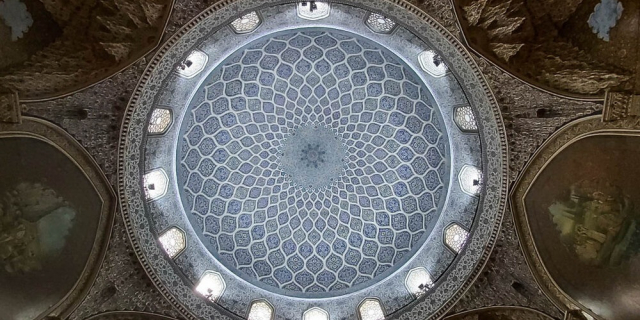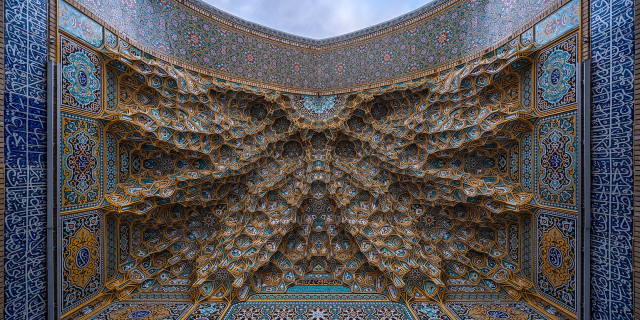کاخ گلستان
( Golestan Palace )The Golestan Palace (Persian: کاخ گلستان, Kākh-e Golestān), also transliterated as the Gulistan Palace and sometimes translated as the Rose Garden Palace from Persian language, was built in the 16th century, renovated in the 18th century and finally rebuilt in 1865. It is the former official royal Qajar complex in Tehran.
One of the oldest historic monuments in the city of Tehran, and a UNESCO World Heritage Site, the Golestan Palace belongs to a group of royal buildings that were once enclosed within the mud-thatched walls of Tehran's arg ("citadel"). It consists of gardens, royal buildings, and collections of Iranian crafts and European presents from the 18th and 19th centuries.
 Exterior view of the marble throne by Eugène Flandin
Exterior view of the marble throne by Eugène FlandinThe origin of the Tehran's royal citadel can be traced back to July 6, 1404; when Ruy González de Clavijo, the envoy of Enrique III, traveled to Samarkand to meet with Timur, and he chose to stay at the house of Baba Sheikh (one of the elders of Tehran). It is believed that his house was located in the area of the royal citadel and later they were transformed into new buildings with changes.[1] The beginning of the royal citadel can be traced back to the time of Suleiman I,[2] with the construction of a palace in the Chenaristan area, a Divankhane where Soltan Hoseyn in the last year of his reign meet with the Ottoman government's ambassador, Ahmad Dari Effendi. Tehran's arg ("citadel") was built during the reign of Tahmasp I (r. 1524–1576) of the Safavid dynasty (1502–1736).[3] Abbas the Great built a big garden in the northern part of the fence, which was later surrounded by a high wall and buildings were built, with the royal residence was built inside it.[4] At the end of the Safavid era, Tehran was sometimes the temporary seat of the court of Safavid kings.[5] The palace was later renovated by Karim Khan of the Zand dynasty (r. 1750–1779).[6] Agha Mohammad Khan of the Qajar dynasty (1742–1797) chose Tehran as his capital.[7] The arg became the seat of the Qajars (1794–1925). The court and palace of Golestan became the official residence of the Qajar dynasty. The palace was rebuilt to its current form in 1865 by Haji Ab ol Hasan Mimar Navai.[8]
During the Pahlavi era (1925–1979), the Golestan Palace was used for formal royal receptions, and the Pahlavi dynasty built their own palace (the Niavaran Complex) in Niavaran. The most important ceremonies held in the palace during the Pahlavi era were the coronation of Reza Shah (r. 1925–1941)[9] on the Marble Throne and the coronation of Mohammad Reza Pahlavi (r. 1941 – 1979) in the Museum Hall. In between 1925 and 1945, a large portion of the buildings of the complex were destroyed on the orders of Reza Shah.[10] He believed that the centuries-old Qajar palace should not hinder the growth of a modern city. In the place of the old buildings, commercial buildings with the modern style of 1950s and 1960s were erected.













![Tasnim News Agency
- CC BY 4.0 [node:title]](/sites/default/files/styles/640x320/public/pla/images/2021-03/Iran_Mall_library.jpeg?h=5374600f&itok=dpY75U_p)


















Add new comment